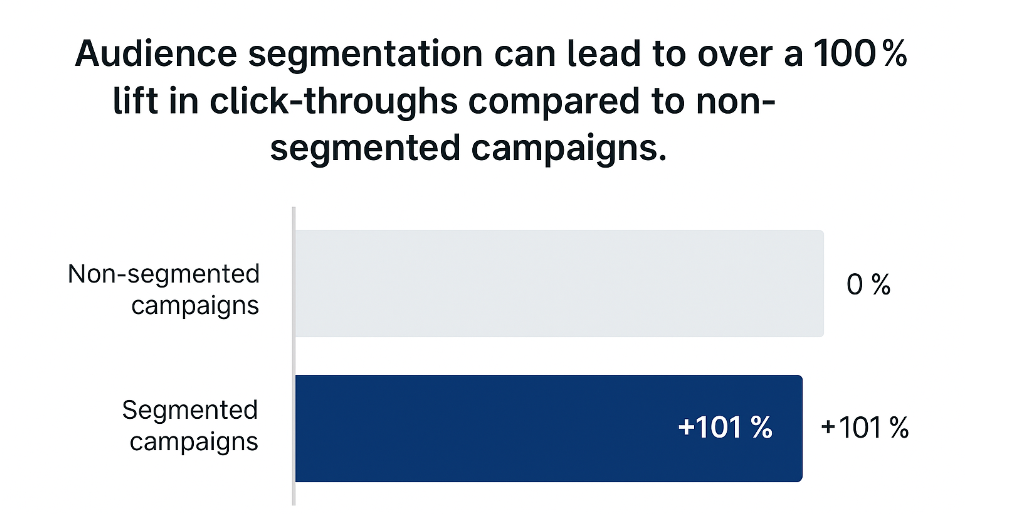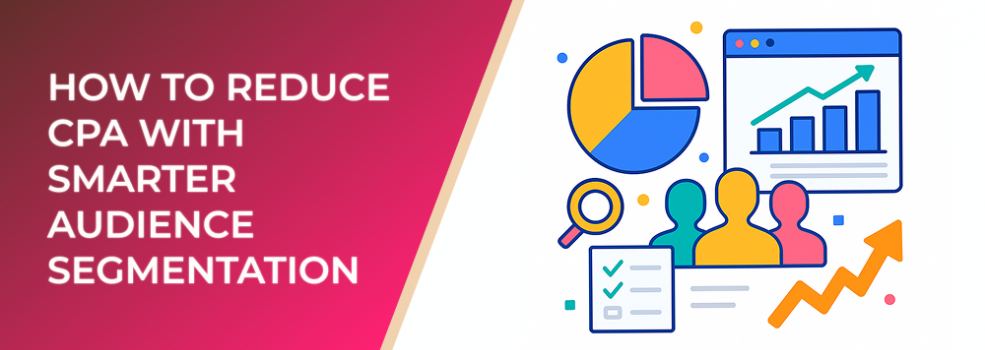In this article, we explore practical strategies and proven methods to optimize your targeting and improve ROI.
Cost per acquisition (CPA) is one of the most critical metrics for marketers. It measures how much you spend to acquire a single paying customer. While ad costs and competition keep rising, there’s a proven way to maintain profitability: smarter audience segmentation.
Why Audience Segmentation Matters
Segmentation helps marketers divide their target audience into smaller, more specific groups based on demographics, interests, behaviors, and purchase intent. By serving tailored messages to each segment, campaigns become more relevant, improving engagement and conversion rates.

Audience segmentation can lead to over a 100% lift in click-throughs compared to non-segmented campaigns
According to HubSpot research, segmented email campaigns drive 14.31% higher open rates and 100.95% higher click-through rates than non-segmented ones. This principle applies equally across all marketing channels.
1. Identify High-Value Segments
Start by analyzing your current audience data. Look at customer lifetime value (CLV), purchase frequency, and average order size. Identify which audience segments generate the highest ROI and focus your budget on those.
For example, a study by Bain & Company found that increasing customer retention by just 5% can boost profits by up to 95%. Focusing on high-value, loyal customer segments ensures you spend smarter, not more.
Key Actions:
-
Use analytics to find patterns among your best customers.
-
Exclude low-performing or unqualified audiences.
-
Reinvest savings from exclusions into higher-performing segments.
2. Use Behavior-Based Targeting
Behavioral segmentation goes beyond demographics. It focuses on actions users take—such as visiting your pricing page, adding items to a cart, or engaging with previous ads.
Targeting based on intent signals increases ad relevance and reduces wasted impressions. Research shows that behavior-based targeting can lower CPA by up to 30% compared to broad targeting.
Key Actions:
-
Create retargeting audiences for users who interacted with your site or ads.
-
Segment by engagement level to tailor ad frequency and messaging.
-
Use lookalike audiences based on your best-converting users.
3. Refine Ad Creatives for Each Segment
Once segments are defined, craft personalized ad creatives. Messaging that resonates with one group may fall flat with another. For instance, highlighting discounts may appeal to budget-conscious customers, while emphasizing exclusivity works better for premium buyers.
Key Actions:
-
A/B test headlines, visuals, and CTAs for each audience group.
-
Match ad copy to user intent and stage in the funnel.
-
Align visuals with audience values and motivations.
4. Continuously Measure and Optimize
Segmentation isn’t static. Consumer behavior changes, and so should your approach. Regularly review campaign metrics such as CTR, conversion rate, and CPA by segment. Identify which audiences respond best and optimize accordingly.
Marketers who perform monthly segmentation reviews see an average of 20% higher conversion rates compared to those who do it quarterly.
Key Actions:
-
Set up automated reports for each segment.
-
Adjust budgets dynamically based on segment performance.
-
Test new segmentation criteria regularly.
Final Thoughts
Smarter segmentation allows you to reach the right people, at the right time, with the right message. By focusing on high-value segments, leveraging behavioral data, personalizing creatives, and continuously optimizing, you can significantly reduce your CPA and improve overall campaign performance.

